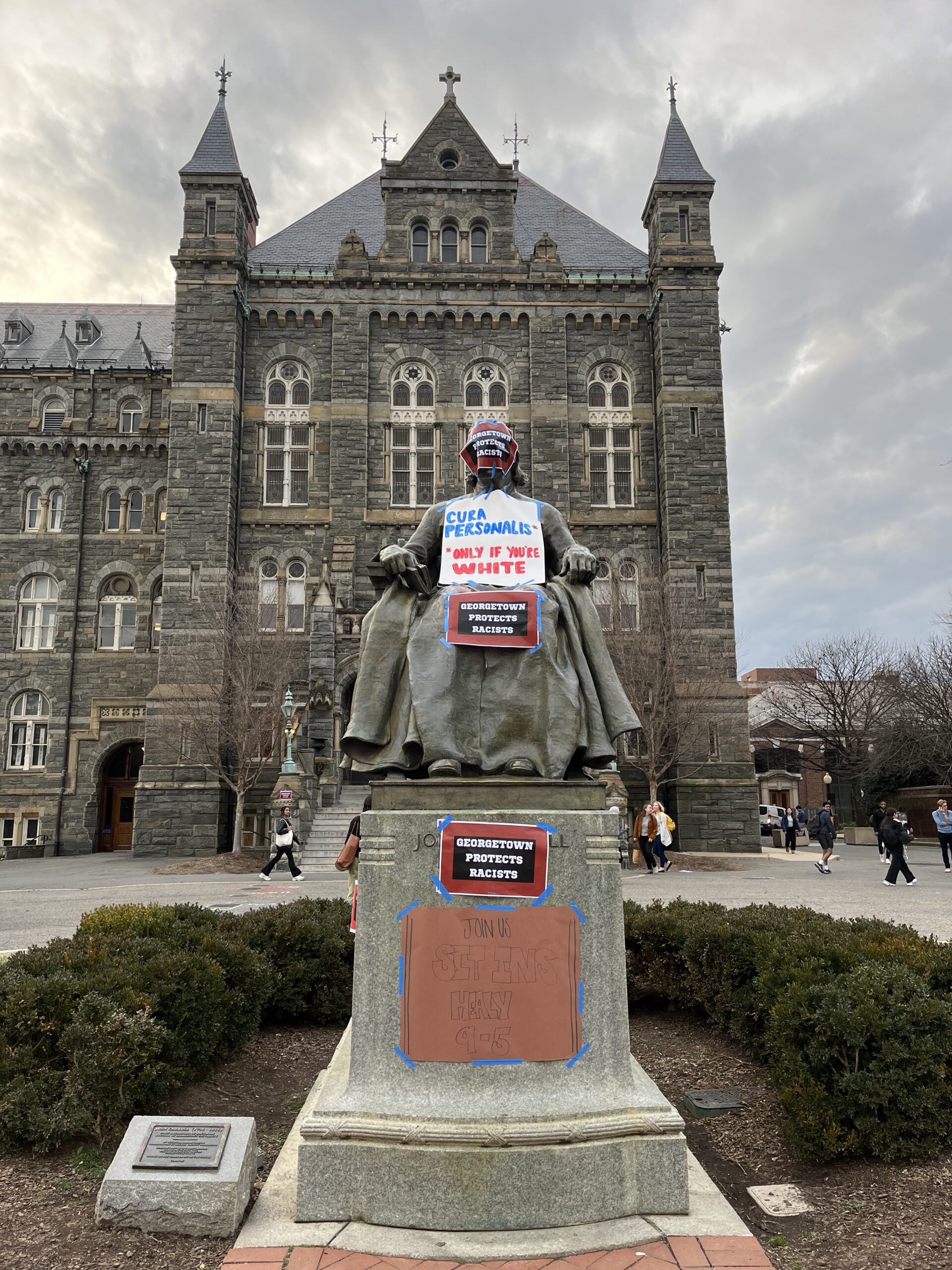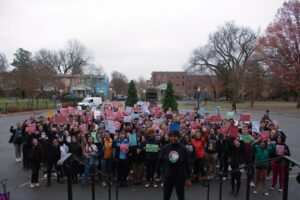Editor’s note and content warning: This article discusses anti-Black hate speech and systemic violence. Find our previous coverage on GUPR’s advocacy, including the initial sit-in protests, here.
On Friday, Feb. 10, Georgetown Protects Racists (GUPR) announced the end of its sit-in protests during a community meeting at 1 p.m. Students initially began occupying Healy Hall by sitting in front of the President’s Office, starting on Dec. 5, 2022, to demand justice for LaHannah Giles (CAS ’23) after they experienced a hate crime on Georgetown’s campus on April 29, 2022. This stage of the sit-in concluded on Dec. 9, when the university agreed to establish a timeline to meet Giles’ demands after neglecting them for over seven months. The sit-ins resumed, however, on Feb. 8, after the university deemed its 10-month-long investigation of the hate crime inconclusive.
According to GUPR’s Instagram account, the report, sent to Giles by the Office for Institutional Diversity, Equity, and Affirmative Action (IDEAA) on Feb. 7, did not identify the perpetrator of the hate crime. The IDEAA office uses a “more likely than not” standard for initiating disciplinary action against a student, and thus their inconclusive finding indicates the university considers the evidence presented against the perpetrator as insufficient.
The university had repeatedly delayed the release of the report, publishing it nearly two months after the initial Dec. 17 deadline organizers said they were promised.
In considering next steps following the report’s conclusion, GUPR organizers decided to end the sit-in on Feb. 10.
“They backed themselves into a corner of inaction,” Sanchi Rohira (SFS ’24) a central organizer for GUPR, said. “And the only way now that anything could happen to the perpetrator of a crime would be if they revised the report, basically like producing a new report saying they came to a different conclusion, which I don’t see happening, because it took 10 months of work to get them to even produce this one, and it was inconclusive.”
The report prompted the organizers to end the sit-ins—but not the movement, they stressed.
“The other organizers and I, with LaHannah’s consultation, have decided that today’s going to be the last day of our sit-ins. And moving forward, our protest is going to take different forms,” Rohira said.
“We kind of have to reimagine what justice looks like, even though it is the hardest thing to do ever,” Rohira added. “We can’t be sitting in forever. I know how many of you have been here day by day in and out. But people get tired.”
Organizers indicated that given the results of the report, shifting focus away from the President’s Office could be beneficial for the evolution of the movement. They see the likelihood of the IDEAA revising the report to be slim and decided to use the community meeting as a way to brainstorm strategies going forward.
Rohira and other organizers kicked off this brainstorming session by emphasizing that, following Giles’ decision to take a step back from spearheading GUPR’s organizing work to prioritize their health and well-being, the movement has increasingly become a collective effort. “GUPR is an entirely community-led movement,” Rohira pronounced. “What that also means is that as of this moment, you are all GUPR organizers, you all have to be GUPR organizers. It’s the only way it’s going to work.”
GUPR organizers see the path forward as one that first and foremost preserves the memory of what happened to Giles and highlights the university’s inability to provide justice. Moreover, Rohira stressed the importance of communicating about the hate crime to parents, so they can “have conversations with their kids about safety and security on campus.”
Just three hours later, though, at approximately 3:47 p.m., a white woman, who said she was a Georgetown parent attending a family event, denounced the sit-in and began removing the explicit GUPR posters that lined the Healy hallway, saying “you are not improving the situation with this language.”
The parent briefly engaged in a verbal confrontation with Giles, who questioned why the parent was offended at the language and not at the hate crime that they had experienced.
“You’re disrespecting all of us in our space and in our community, so you can leave,” Giles said.
Following their conversation, the parent left and the students proceeded to tape the posters back up.
When it comes to prospective students, awareness of Georgetown’s institutional racism is crucial, according to Rohira. “I think they deserve to know what happened on campus and how the administration handled it,” she said. “Prospective students deserve to know what they might be getting into before they decide to come to this school, particularly any first-generation or minority prospective students.”
Students in attendance at the meeting shared their own ideas on anti-racist advocacy moving forward. Rohira, noting that students involved in Blue & Gray have been present at the sit-ins, suggested they share the honest story of what happened to Giles. “For example, if you are doing a tour on campus, and when you’re passing by Healy Hall, you talk about Healy Hall as the site of weeks-long sit-ins for a case in which a hate crime occurred on campus and the university did nothing about it,” she said.
Rohira also brought up the prospect of collaborating with student-athletes to advocate for GUPR at games, bringing up Giles’ case during conversations and lectures about racial justice on campus, and creating a GUPR emblem for students to carry around. An audience member suggested the creation of a toolkit for community involvement in organizing. Another discussion centered on ways to memorialize the upcoming one-year anniversary of the hate crime in April.
GUPR organizers, however, said it’s important to first find a space for communal self-care. They announced at the community meeting that they are planning on holding a rally for care, reflection, and communal healing next Sunday, Feb. 19, which will include a silent walk around campus.
“We all need to heal, and so we’re going to try and create a space for that,” Rohira said. “It’s up to us.”
Note: this story has been updated to reflect that it is the IDEAA office, not the university as a whole, that uses a “more likely than not” standard, and to properly attribute claims that the university promised to complete the report by Dec. 17 to organizers.





